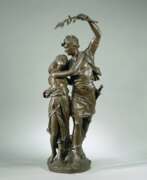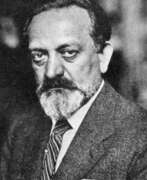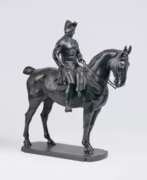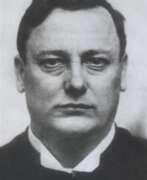Medalists 19th century


Georg Conrad Ludwig Burger was a German historical painter, illustrator, and medallist. He studied at the Berlin Art Academy, at the same time working at book illustrating; he was also a pupil of Thomas Couture in Paris. Among his best drawings are the illustrations for the works of La Fontaine and a collection of 20 plates known as Die Kanone. After 1869, he devoted himself to decorative painting, his most important work in this line being the walls and ceilings in the Berlin City Hall (1870) and the colossal figures symbolizing the warlike virtues at the School of Cadets at Lichterfelde (1878).


Giannino Castiglioni was an Italian sculptor and medallist. He worked mostly in monumental and funerary sculpture; his style was representational, and far from the modernist and avant-garde trends of the early twentieth century.


Auguste de Niederhäusern, better known as Rodo, was a Swiss sculptor and medallist. He is considered one of the most influential representatives of Swiss Symbolism.
In 1892 Rodo took part in the Salon de la Rose-Croix exhibition and for the next six years was a collaborator of Auguste Rodin.
Between 1900 and 1902, Rodot created several works for the Federal Palace in Bern, which was under construction: at the top of the pediment is a sculptural group symbolising political independence, executive and legislative power; he also created the capstones on the arched windows of the south façade.


Ernst Moritz Geyger was a German artist known for his work in sculpture, painting and engraving. His work is included in the collections of the Los Angeles County Museum of Art, the Carnegie Museum of Art and the Fine Arts Museums of San Francisco.




Constant Montald was a Belgian painter, muralist, sculptor, and teacher. In 1874, while receiving an education in decorative painting at the technical school of Ghent during the day, Montald also enrolled in the evening-classes of the Royal Academy of Fine Arts in Ghent. There he won in 1885 a competition and received a grant from the city which enabled him to live and study briefly in Paris at the École des Beaux-Arts. In Paris he painted his first monumental canvas, The Human Struggle. In 1886, Montald went on to win the Belgian Prix de Rome. He then went on a grand tour of Italy. He traveled extensively until he eventually settled in Florence, where he made preparations for a Grand work he eventually completed in Rome. This grand work, titled "Social Contradictions", was kept in the basement of the Royal Museum of Art and History of Brussels after it was displayed there in 1890 after being sent over from Rome. The First World War prevented Montald from painting Monumental works, instead he focused on painting on an easel. Montald co-founded the group L'art monumental. This group promoted a decorative monumental style connected to architecture.


Georges Morin was a German painter, sculptor, and medalist, showcased his versatility through architecture sculptures, standalone artworks, medals, statues, and figures.
Morin studied at the Berlin Art Academy from 1892 to 1896, learning under Ernst Herter and Peter Breuer. Following his successful exams, he journeyed to Paris for further studies, captivated by oriental dancers of Commedia dell'arte. Morin painted and sculpted these dancers, drawing inspiration from their performances. He also traveled to Italy and England before returning to Berlin, residing on Görrestraße 16 in Berlin-Friedenau. He was surrounded by fellow artists in the vicinity. Morin's affiliations included the District Art Deputation and associations of visual artists in Berlin and Germany, providing him platforms to exhibit his creations.




Ivan Ivanovich Reimers (Russian: Иван Иванович Реймерс) was a mid-nineteenth-century Russian artist of German origin. He is known as a painter, medallist and sculptor.
As a sculptor, Ivan Reimers became famous for creating bas-reliefs on religious themes for churches and decorating the Hermitage building in St. Petersburg. As a painter, the artist showed himself as a genre painter, landscape painter, portrait painter. He also worked successfully in watercolors.


Richard Scheibe was a German artist primarily remembered as a sculptor. He trained as a painter, and taught himself to sculpt beginning in 1906. From 1925-1933 he taught at the Städelsches Kunstinstitut in Frankfurt am Main. He was dismissed from teaching when the Nazis seized power but was reinstated in 1934. He received various recognitions during the Third Reich, including the Goethe-Medaille für Kunst und Wissenschaft and placement on the Gottbegnadeten list. After World War II he continued to sculpt, including a figurative piece for the Memorial to the German Resistance. His work was also part of the sculpture event in the art competition at the 1928 Summer Olympics.


Helena Skirmunt was a Polish, Lithuanian, and Belarusian artist of the mid-19th century. She is known as a painter, graphic artist and sculptor.
As an artist, Helena Skirmunt painted landscapes, portraits, and icons; as a sculptor, she created numerous portrait medallions and religious works. She was also famous for creating "historical" chess pieces, choosing as their theme the Viennese campaign of the Polish King Jan III Sobieski, who defeated the Turkish army in 1683.


Arthur Storch was a German sculptor and porcelain modeller.
Born and raised in a family of artists, Storch was trained as a modeller at the Volkstädter porcelain factory and then studied at the Bavarian Academy of Fine Arts. Having established himself as a sculptor and medallist, he worked in Munich and Hamburg, and contributed to architectural jewellery in cities such as Wiesbaden and Hamburg. His legacy includes around 100 drawings, 12 medals and 40 sculptures.


Fyodor Petrovich Tolstoy (Russian: Фёдор Петрович Толстой) was a Russian sculptor, painter, and medallist, renowned for his contributions to Russian classicism and romanticism. Born in Saint Petersburg in 1783, he became a prominent figure in the Russian art world. As a vice-president of the Imperial Academy of Arts, Tolstoy produced significant works, including medallions commemorating the Patriotic War of 1812.
Tolstoy's artistic style is characterized by its meticulous detail and classical influence. His works, such as the intricate medallions and bas-reliefs, often depict historical and allegorical scenes. These pieces are celebrated for their technical precision and emotional depth, embodying the spirit of the era.
Many of Tolstoy's creations are housed in prestigious collections, including the State Hermitage Museum and the State Tretyakov Gallery. His legacy continues to inspire and influence Russian art and culture, making him a significant figure in the history of Russian fine arts.
Subscribe for updates on new product sales and auction events related to Fyodor Petrovich Tolstoy. Stay informed about the latest opportunities to acquire pieces of his artistic legacy.


Dominique Vivant, Baron Denon was a French artist, writer, diplomat, author, and archaeologist. Denon was a diplomat for France under Louis XV and Louis XVI. He was appointed as the first Director of the Louvre museum by Napoleon after the Egyptian campaign of 1798-1801, and is commemorated in the Denon Wing of the modern museum and in the Dominique-Vivant Denon Research Center. His two-volume Voyage dans la basse et la haute Egypte ("Journey in Lower and Upper Egypt"), 1802, was foundational for modern Egyptology.


Adolf von Hildebrand was a German sculptor of the second half of the 19th and early 20th centuries, a representative of academism. He was also fond of architecture, painting, graphics and medallions.
Adolf von Hildebrand is also known as an authoritative art theorist, his fundamental work "The Problem of Form in Fine Art," first published in 1892, was subsequently translated into dozens of foreign languages.
Hildebrand spent much of his life outside Germany. In Italy he was strongly impressed by the work of the best masters of antiquity and the Renaissance. Soon, together with a group of like-minded people, he founded the "Roman circle". The members of this creative association urged their colleagues to abandon decadent attitudes in favor of the true values of ancient art.
In recognition of his achievements, the King of Bavaria knighted Hildebrand at the end of his life and the aristocratic prefix "von" was added to his name. The sculptor's works have survived in many European cities, but his most famous architectural and sculptural works are in Munich.

































































